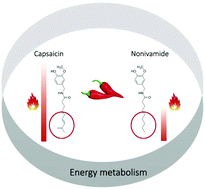Capsaicin and nonivamide similarly modulate outcome measures of mitochondrial energy metabolism in HepG2 and 3T3-L1 cells
Abstract
Capsaicin, the highly pungent principle of red pepper, has been demonstrated to have anti-obesity properties by affecting energy and lipid metabolism. Recent evidence from human intervention trials shows that also less pungent capsaicin analogs, like nonivamide, may help to reduce total body fat, although mechanistic data comparing the effects of capsaicin and nonivamide on outcome measures of energy metabolism are lacking. Here, the tissue-specific effects of capsaicin and nonivamide on parameters of mitochondrial energy metabolism in 3T3-L1 and HepG2 cells are investigated. Lipid accumulation was reduced to a similar extent after treatment with both test substances during the maturation of 3T3-L1 cells by up to 6.91% for capsaicin and up to 4.89% for nonivamide (p < 0.01) at a concentration of 0.1 μM or 1 μM, respectively. Energy-producing pathways, as indicated by the reduced mitochondrial oxygen consumption and reduced glucose and fatty acid uptake, were diminished after incubation with both capsaicinoids at a concentration of 100 μM. The results from HPLC analyses revealed a reduced cellular energy charge potential after a 4 h treatment with nonivamide. In HepG2 cells, similar effects were demonstrated: the glucose uptake was reduced by 18.7% and 25.8% (p < 0.05), after a 24 h incubation with 100 μM capsaicin and nonivamide, respectively. In addition, the fatty acid uptake and oxygen consumption were decreased and the energy charge potential was diminished. These findings provide evidence that concentrations of capsaicin and nonivamide between 0.1 and 100 μM modulate the mechanisms of cellular energy metabolism to a similar extent, independent of the investigated tissue.



 Please wait while we load your content...
Please wait while we load your content...